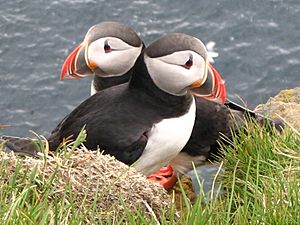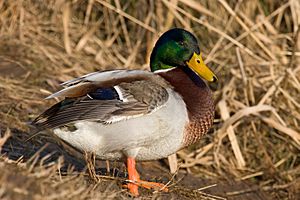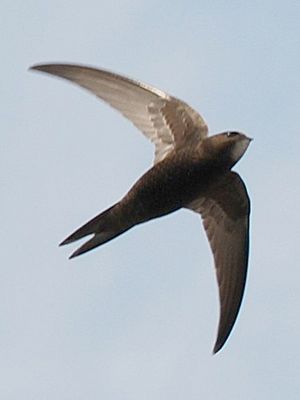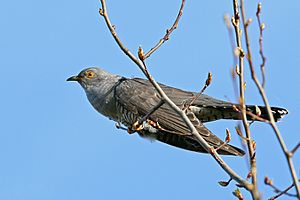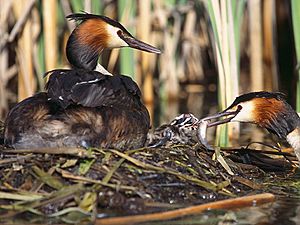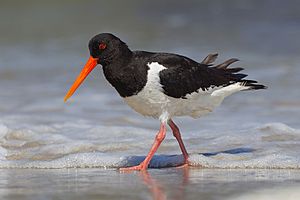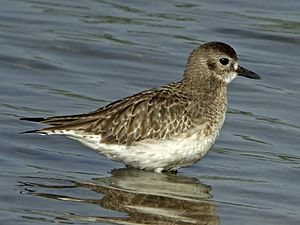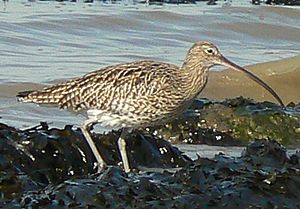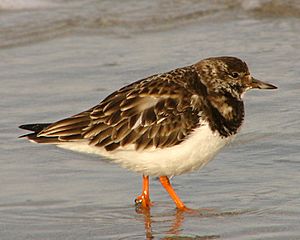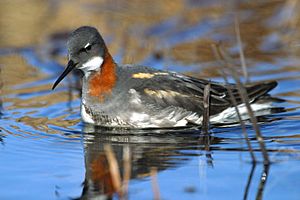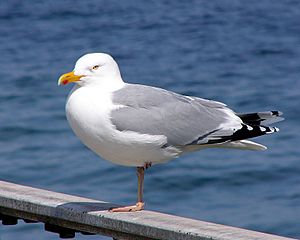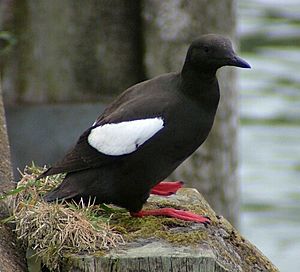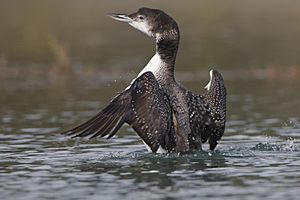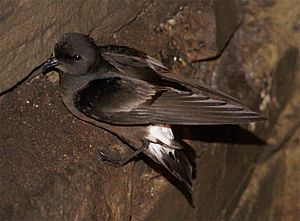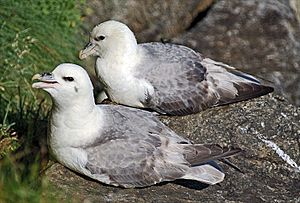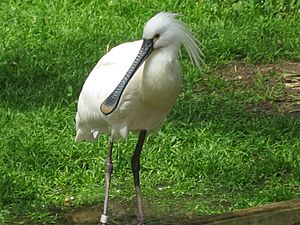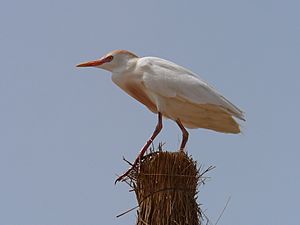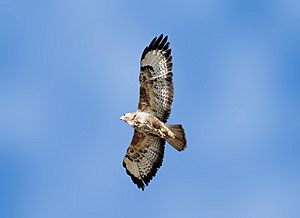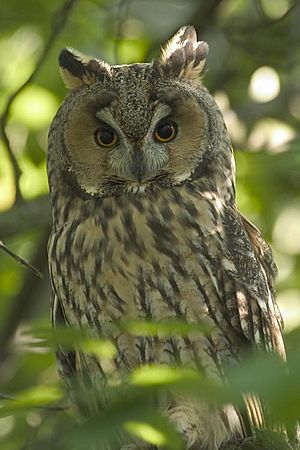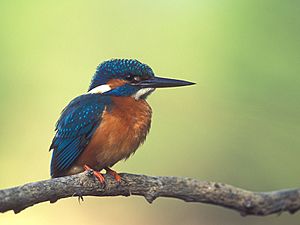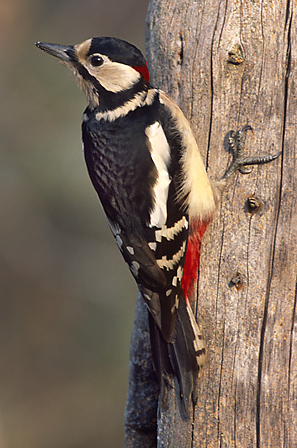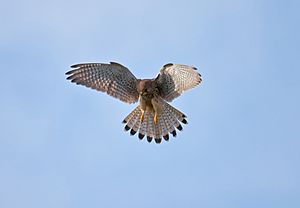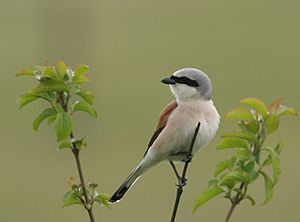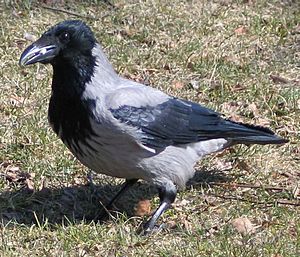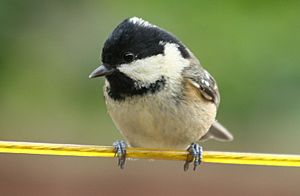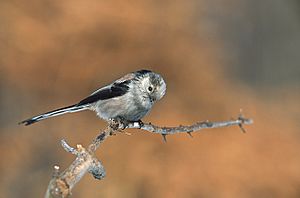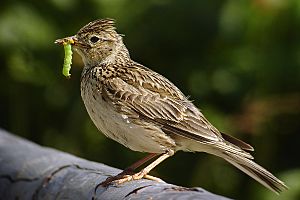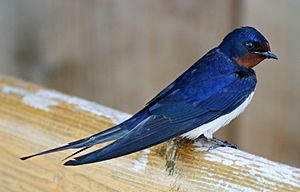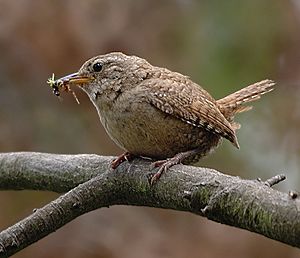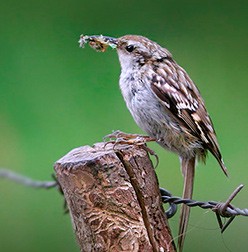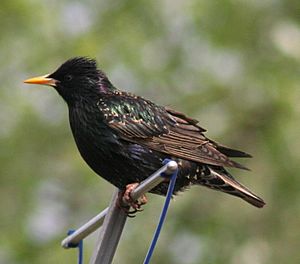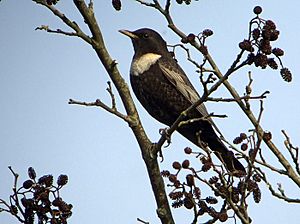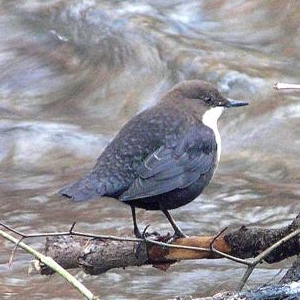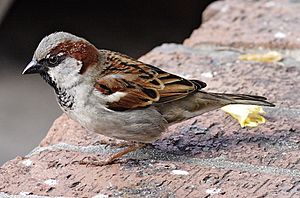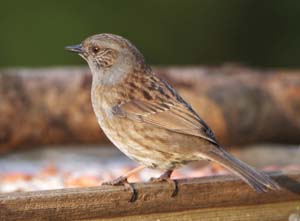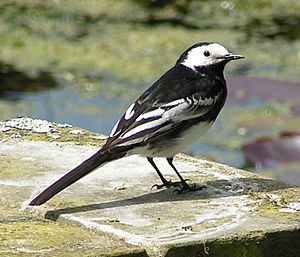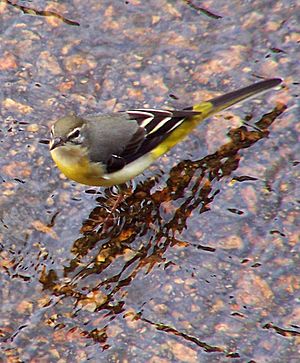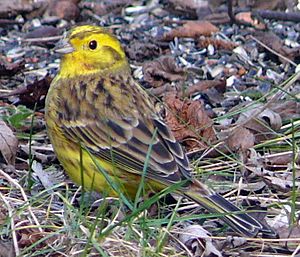List of birds of Ireland facts for kids
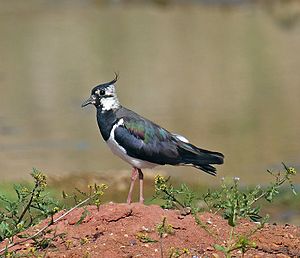
Ireland is home to many different kinds of birds! As of 2019, experts from the Irish Rare Birds Committee (IRBC) have counted 522 different bird species here. Some of these birds are quite rare, and 14 of the rarest haven't been seen in Ireland since 1950. A few species were brought to Ireland by people or came from other places where they were introduced.
Ireland doesn't have as many types of breeding birds as some other places because it's an island. For example, birds like the tawny owl or Eurasian nuthatch that live in Great Britain don't usually breed here. However, Ireland has huge groups of seabirds, including important numbers of European storm-petrels, northern gannets, and roseate terns. Other special birds that breed here are corn crakes and red-billed choughs. While Ireland doesn't have any bird species found nowhere else in the world, it does have unique types (subspecies) of white-throated dippers, coal tits, and Eurasian jays.
Many wildfowl (like ducks and geese) and wading birds come to Ireland for the winter because of its mild weather. About half of the world's Greenland greater white-fronted geese spend their winter here! In autumn, you can spot many migrating seabirds off the coast, such as different kinds of skuas, shearwaters, and petrels. Because Ireland is so far west, birds from North America often visit in the autumn.
The names and groups of birds in this list follow the rules set by the International Ornithological Congress (IOC) from July 2021. Many of the Irish names come from the National Terminology Database for Irish.
The Irish Rare Birds Committee (IRBC) uses special tags (A, B, C, and R) to describe how often a bird species is seen in Ireland.
- A - These birds have been seen in a natural, wild state in Ireland at least once since January 1, 1950.
- B - These birds were seen in a natural, wild state in Ireland before December 31, 1949, but haven't been seen since. This includes very old rare sightings or species that no longer live here.
- C - These birds were originally brought to Ireland by people but have now created their own wild groups that can survive without more birds being brought in. It also includes birds that came from wild groups outside Ireland.
- R - This means the bird is rare and needs special details to confirm its sighting.
Contents
- Ducks, Geese, and Swans
- Pheasants and Their Relatives
- Nightjars
- Swifts
- Cuckoos
- Pigeons and Doves
- Rails, Crakes, and Coots
- Cranes
- Grebes
- Oystercatchers
- Plovers
- Sandpipers and Snipes
- Gulls, Terns, and Skimmers
- Skuas
- Auks
- Loons (Divers)
- Northern Storm Petrels
- Petrels and Shearwaters
- Gannets and Boobies
- Cormorants and Shags
- Ibises and Spoonbills
- Herons and Bitterns
- Osprey
- Kites, Hawks, and Eagles
- Barn Owls
- Owls
- Hoopoes
- Kingfishers
- Woodpeckers
- Falcons
- Shrikes
- Crows and Jays
- Waxwings
- Tits and Chickadees
- Bushtits
- Larks
- Swallows and Martins
- Goldcrests and Kinglets
- Wrens
- Treecreepers
- Starlings
- Thrushes
- Chats and Old World Flycatchers
- Dippers
- Old World Sparrows
- Accentors
- Wagtails and Pipits
- Finches
- Snow Buntings
- Buntings
- New World Warblers
- See also
Ducks, Geese, and Swans
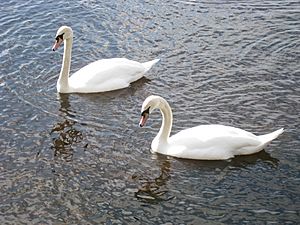
Order: Anseriformes Family: Anatidae
This family includes ducks, geese, and swans. These birds are great at living in water! They have webbed feet, flat bills, and feathers that shed water easily because of a special oily coating.
| Common name | Scientific name | Irish name | Status |
|---|---|---|---|
| Brant goose | Branta bernicla | Cadhan | A |
| Barnacle goose | Branta leucopsis | Gé ghiúrainn / cadhan | A |
| Greylag goose | Anser anser | Crann-ghé / gé mhór fhionn / gé ghlas | A |
| Greater white-fronted goose | Anser albifrons | Gé bhánéadanach mhór | A |
| Mute swan | Cygnus olor | Eala bhalbh | A |
| Whooper swan | Cygnus cygnus | Eala ghlórach | A |
| Common shelduck | Tadorna tadorna | Seil-lacha | A |
| Mandarin duck | Aix galericulata | Lacha mhandarin | C |
| Northern shoveler | Spatula clypeata | Slapaire tuaisceartach | A |
| Gadwall | Mareca strepera | Gadual | A |
| Eurasian wigeon | Mareca penelope | Rualacha | A |
| Mallard | Anas platyrhynchos | Mallard | A |
| Northern pintail | Anas acuta | Biorearrach tuaisceartach | A |
| Eurasian teal | Anas crecca | Praslacha ghlaseiteach | A |
| Common pochard | Aythya ferina | Póiseard cíordhearg / lacha mhásach | A |
| Tufted duck | Aythya fuligula | Lacha bhadánach | A |
| Greater scaup | Aythya marila | Lacha iascán mór | A |
| Common eider | Somateria mollissima | Éadar | A |
| Common scoter | Melanitta nigra | Scótar / lacha scótarach | A |
| Long-tailed duck | Clangula hyemalis | Lacha earrfhada | A |
| Common goldeneye | Bucephala clangula | Órshúileach | A |
| Common merganser | Mergus merganser | Síolta / tumaire | A |
| Red-breasted merganser | Mergus serrator | Síolta rua | A |
| Ruddy duck | Oxyura jamaicensis | Lachra rua | C |
Pheasants and Their Relatives
Order: Galliformes Family: Phasianidae
This family includes birds like quails, partridges, and pheasants. They are usually plump birds that live on the ground and have broad, short wings.
| Common name | Scientific name | Irish name | Status |
|---|---|---|---|
| Grey partridge | Perdix perdix | Cearc coille | A |
| Common quail | Coturnix coturnix | Gearg / gearraghuirt | A |
| Common pheasant | Phasianus colchicus | Feasán mhuinceach | C |
Nightjars
Order: Caprimulgiformes Family: Caprimulgidae
Nightjars are medium-sized birds that are active at night. They usually build their nests on the ground. They have long wings, short legs, and very short bills. Their soft feathers help them blend in with tree bark or leaves.
| Common name | Scientific name | Irish name | Status |
|---|---|---|---|
| European nightjar | Caprimulgus europaeus | Tuirne lín | A |
Swifts
Order: Apodiformes Family: Apodidae
Swifts are small birds that spend most of their lives flying! They have very short legs and almost never land on the ground. Instead, they perch on vertical surfaces. Many swifts have long, swept-back wings that look like a boomerang.
| Common name | Scientific name | Irish name | Status |
|---|---|---|---|
| Alpine swift | Tachymarptis melba | Gabhlán alpach | A |
| Common swift | Apus apus | Gabhlán gaoithe | A |
Cuckoos
Order: Cuculiformes Family: Cuculidae
The cuckoo family includes birds with slender bodies, long tails, and strong legs. Many Old World cuckoos are "brood parasites," meaning they lay their eggs in other birds' nests!
| Common name | Scientific name | Irish name | Status |
|---|---|---|---|
| Common cuckoo | Cuculus canorus | Cuach | A |
Pigeons and Doves
Order: Columbiformes Family: Columbidae
Pigeons and doves are birds with sturdy bodies, short necks, and thin bills.
| Common name | Scientific name | Irish name | Status |
|---|---|---|---|
| Rock dove | Columba livia | Colm aille | A |
| Stock dove | Columba oenas | Colm gorm | A |
| Common wood pigeon | Columba palumbus | Colm coille | A |
| European turtle dove | Streptopelia turtur | Fearán | A |
| Eurasian collared dove | Streptopelia decaocto | Fearán baicdhubh | A |
Rails, Crakes, and Coots
Order: Gruiformes Family: Rallidae
This large family includes rails, crakes, and coots. They usually live in thick plants near lakes, swamps, or rivers. They are often shy and hard to spot. Most have strong legs and long toes, which help them walk on soft ground. They tend to have short, rounded wings and aren't very strong fliers.
| Common name | Scientific name | Irish name | Status |
|---|---|---|---|
| Water rail | Rallus aquaticus | Rálóg uisce / tradhna uisce | A |
| Corn crake | Crex crex | Traonach | A |
| Spotted crake | Porzana porzana | Gearr breac | A |
| Common moorhen | Gallinula chloropus | Cearc uisce / truisc / coileach fraoich | A |
| Eurasian coot | Fulica atra | Cearc cheannann | A |
Cranes
Order: Gruiformes Family: Gruidae
Cranes are large birds with long legs and long necks. Unlike herons (which look similar), cranes fly with their necks stretched out, not pulled back. Many cranes have special, noisy dances they do to attract a mate.
| Common name | Scientific name | Irish name | Status |
|---|---|---|---|
| Common crane | Grus grus | Corr / grús | A |
Grebes
Order: Podicipediformes Family: Podicipedidae
Grebes are small to medium-sized diving birds that live in freshwater. They have lobed toes and are excellent swimmers and divers. However, their feet are set far back on their bodies, making them clumsy on land.
| Common name | Scientific name | Irish name | Status |
|---|---|---|---|
| Little grebe | Tachybaptus ruficollis | Spágaire tonn / tomaire beag | A |
| Great crested grebe | Podiceps cristatus | Foitheach mór / Lúnadán mór an chorraicín | A |
| Horned grebe | Podiceps auritus | Beann-foitheach | A |
| Black-necked grebe | Podiceps nigricollis | Foithíoch cluasach | A |
Oystercatchers
Order: Charadriiformes Family: Haematopodidae
Oystercatchers are large, noisy birds that look a bit like plovers. They have strong bills that they use to smash open or pry apart shellfish.
| Common name | Scientific name | Irish name | Status |
|---|---|---|---|
| Eurasian oystercatcher | Haematopus ostralegus | Roilleach / riabhán / scaladóir | A |
Plovers
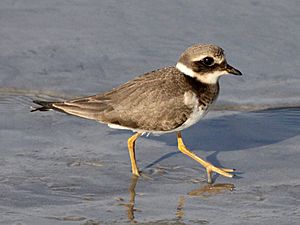
Order: Charadriiformes Family: Charadriidae
This family includes plovers, dotterels, and lapwings. They are small to medium-sized birds with compact bodies, short necks, and long, pointed wings. You can find them in open areas all over the world, especially near water.
| Common name | Scientific name | Irish name | Status |
|---|---|---|---|
| Northern lapwing | Vanellus vanellus | Saotharcán Tuaisceartach | A |
| European golden plover | Pluvialis apricaria | Feadóg bhuí / fideog | A |
| Grey plover | Pluvialis squatarola | Feadóg bolgdubh | A |
| Common ringed plover | Charadrius hiaticula | Feadóg chladaigh / feadóg an fháinne / ladhrán | A |
Sandpipers and Snipes
Order: Charadriiformes Family: Scolopacidae
This is a large and varied family of small to medium-sized shorebirds, including sandpipers, curlews, godwits, and snipes. Most of these birds eat small insects and other tiny creatures they find in mud or soil. Their different leg and bill lengths allow many species to feed in the same places, especially along the coast, without competing for food.
| Common name | Scientific name | Irish name | Status |
|---|---|---|---|
| Eurasian whimbrel | Numenius phaeopus | Crotach eanaigh | A |
| Eurasian curlew | Numenius arquata | Crotach / cruiteach | A |
| Bar-tailed godwit | Limosa lapponica | Guibneach stríocearrach | A |
| Black-tailed godwit | Limosa limosa | Guilbneach earrdubh | A |
| Ruddy turnstone | Arenaria interpres | Piadálai trá ruadh | A |
| Red knot | Calidris canutus | Cnota rua | A |
| Ruff | Calidris pugnax | Rufachán | A |
| Curlew sandpiper | Calidris ferruginea | Gobadán crotaigh | A |
| Sanderling | Calidris alba | Luathrán | A |
| Dunlin | Calidris alpina | Breacó | A |
| Purple sandpiper | Calidris maritima | Gobadan cosbhuí | A |
| Little stint | Calidris minuta | Gobadáinín beag | A |
| Pectoral sandpiper | Calidris melanotos | Gobadán uchtach | A |
| Eurasian woodcock | Scolopax rusticola | Creabhar | A |
| Jack snipe | Lymnocryptes minimus | Naoscach bhídeach | A |
| Common snipe | Gallinago gallinago | Naoscach | A |
| Red-necked phalarope | Phalaropus lobatus | Falaróp gobchaol | A |
| Red phalarope | Phalaropus fulicarius | Falaróp rua | A |
| Common sandpiper | Actitis hypoleucos | Gobadán coiteann | A |
| Green sandpiper | Tringa ochropus | Gobadán glas | A |
| Common redshank | Tringa totanus | Cosdeargán | A |
| Wood sandpiper | Tringa glareola | Gobadán coille | A |
| Spotted redshank | Tringa erythropus | Cosdeargán breac | A |
| Common greenshank | Tringa nebularia | Ladhrán glas | A |
Gulls, Terns, and Skimmers
Order: Charadriiformes Family: Laridae
This family includes gulls, terns, and skimmers. Gulls are usually grey or white, often with black markings. They have strong bills and webbed feet. Terns are generally medium to large seabirds, often with grey or white feathers and black markings on their heads. Most terns catch fish by diving, but some pick insects off the water's surface. Terns can live for a long time, with some species living over 30 years.
| Common name | Scientific name | Irish name | Status |
|---|---|---|---|
| Black-legged kittiwake | Rissa tridactyla | Saidhbhéar | A |
| Sabine's gull | Xema sabini | Sléibhín Sabine | A |
| Bonaparte's gull | Chroicocephalus philadelphia | Sléibhín Bonaparte | A |
| Black-headed gull | Chroicocephalus ridibundus | Sléibhín | A |
| Little gull | Hydrocoloeus minutus | Sléibhín beag | A |
| Mediterranean gull | Ichthyaetus melanocephalus | Sléibhín meánmhuirí | A |
| Common gull | Larus canus | Faoileán bán | A |
| Ring-billed gull | Larus delawarensis | Faoileán bandghobach | A |
| Great black-backed gull | Larus marinus | Droimneach mór | A |
| Glaucous gull | Larus hyperboreus | Faoileán glas | A |
| Iceland gull | Larus glaucoides | Faoileán Íoslannach | A |
| European herring gull | Larus argentatus | Faoileán scadán | A |
| Lesser black-backed gull | Larus fuscus | Droimneach beag | A |
| Sandwich tern | Thalasseus sandvicensis | Geabhróg scothdhubh | A |
| Little tern | Sternula albifrons | Geabhróg bheag | A |
| Roseate tern | Sterna dougallii | Geabhróg rosach | A |
| Common tern | Sterna hirundo | Geabhróg | A |
| Arctic tern | Sterna paradisaea | Geabhróg Artach | A |
| Black tern | Chlidonias niger | Geabhróg dhubh | A |
Skuas
Order: Charadriiformes Family: Stercorariidae
Skuas are medium to large birds, usually grey or brown, often with white marks on their wings. They nest on the ground in cooler regions and travel long distances.
| Common name | Scientific name | Irish name | Status |
|---|---|---|---|
| Great skua | Stercorarius skua | Meirleach mór | A |
| Pomarine jaeger | Stercorarius pomarinus | Meirleach pomairíneach | A |
| Parasitic jaeger | Stercorarius parasiticus | Meirleach Artach | A |
| Long-tailed jaeger | Stercorarius longicaudus | Meirleach earrfhada | A |
Auks
Order: Charadriiformes Family: Alcidae
Alcids look a bit like penguins because of their black and white colours and upright way of standing. However, they are not related to penguins and can fly! Auks live on the open sea and only come ashore to nest.
| Common name | Scientific name | Irish name | Status |
|---|---|---|---|
| Little auk | Alle alle | Foracha bheag | A |
| Common murre | Uria aalge | Foracha | A |
| Razorbill | Alca torda | Crosán | A |
| Great auk | Pinguinus impennis | Foracha mhór | B (extinct) |
| Black guillemot | Cepphus grylle | Foracha dhubh | A |
| Atlantic puffin | Fratercula arctica | Puifín | A |
Loons (Divers)
Order: Gaviiformes Family: Gaviidae
Loons, also called divers, are water birds found in North America and northern Europe. They are about the size of a large duck or small goose, and look similar when swimming, but they are not related.
| Common name | Scientific name | Irish name | Status |
|---|---|---|---|
| Red-throated loon | Gavia stellata | Lóma rua | A |
| Black-throated loon | Gavia arctica | Lóma Artach | A |
| Common loon | Gavia immer | Lóma mór | A |
Northern Storm Petrels
Order: Procellariiformes Family: Hydrobatidae
These storm petrels are small seabirds that are related to other petrels. They eat tiny sea creatures and small fish from the water's surface, often while hovering. Their flight can be fluttery, almost like a bat.
| Common name | Scientific name | Irish name | Status |
|---|---|---|---|
| European storm petrel | Hydrobates pelagicus | Guairdeall | A |
| Leach's storm petrel | Hydrobates leucorhous | Guairdeall gabhlach | A |
Petrels and Shearwaters
Order: Procellariiformes Family: Procellariidae
This group includes medium-sized "true petrels." They are known for their united nostrils and a long outer primary feather.
| Common name | Scientific name | Irish name | Status |
|---|---|---|---|
| Northern fulmar | Fulmarus glacialis | Fulmaire | A |
| Cory's shearwater | Calonectris borealis | Cánóg Cory | A |
| Sooty shearwater | Ardenna griseus | Cánóg dhorcha | A |
| Great shearwater | Ardenna gravis | Cánóg mhór | A |
| Manx shearwater | Puffinus puffinus | Cánóg dhubh | A |
| Balearic shearwater | Puffinus mauretanicus | A |
Gannets and Boobies
Order: Suliformes Family: Sulidae
This family includes gannets and boobies. Both are medium to large seabirds that live near coasts and dive headfirst into the water to catch fish.
| Common name | Scientific name | Irish name | Status |
|---|---|---|---|
| Northern gannet | Morus bassanus | Gainead | A |
Cormorants and Shags
Order: Suliformes Family: Phalacrocoracidae
This family includes cormorants and shags, which are medium to large seabirds that eat fish. Most of them have dark feathers, but some are black and white, and a few are very colourful.
| Common name | Scientific name | Irish name | Status |
|---|---|---|---|
| Great cormorant | Phalacrocorax carbo | Broigheall | A |
| European shag | Gulosus aristotelis | Seaga | A |
Ibises and Spoonbills
Order: Pelecaniformes Family: Threskiornithidae
This family includes ibises and spoonbills, which are large birds that live on land and in water. They have long, broad wings and are strong fliers, even though they are big and heavy.
| Common name | Scientific name | Irish name | Status |
|---|---|---|---|
| Glossy ibis | Plegadis falcinellus | Íbis niamhrach | A |
| Eurasian spoonbill | Platalea leucorodia | Corr leitheadach Eoráiseach | A |
Herons and Bitterns
Order: Pelecaniformes Family: Ardeidae
This family includes bitterns, herons, and egrets. Herons and egrets are medium to large wading birds with long necks and legs. Bitterns are usually shorter-necked and more cautious. Unlike other long-necked birds like storks, herons and egrets fly with their necks pulled back.
| Common name | Scientific name | Irish name | Status |
|---|---|---|---|
| Eurasian bittern | Botaurus stellaris | Bonnán | A |
| Black-crowned night heron | Nycticorax nycticorax | Corr oíche | A |
| Western cattle egret | Bubulcus ibis | Éigrit eallaigh | A |
| Grey heron | Ardea cinerea | Corr réisc | A |
| Little egret | Egretta garzetta | Éigrit bheag | A |
Osprey
Order: Accipitriformes Family: Pandionidae
This family has only one species, the osprey. Ospreys are medium-large birds of prey that specialize in eating fish.
| Common name | Scientific name | Irish name | Status |
|---|---|---|---|
| Osprey | Pandion haliaetus | Coirneach | A |
Kites, Hawks, and Eagles
Order: Accipitriformes Family: Accipitridae
This family includes birds of prey like hawks, eagles, kites, and harriers. These birds have strong, hooked beaks for tearing meat, powerful legs, sharp talons, and excellent eyesight.
| Common name | Scientific name | Irish name | Status |
|---|---|---|---|
| Golden eagle | Aquila chrysaetos | Iolar firéan | A R |
| Eurasian sparrowhawk | Accipiter nisus | Spioróg | A |
| Hen harrier | Circus cyaneus | Cromán na gcearc | A |
| Red kite | Milvus milvus | Cúr rua | A |
| White-tailed eagle | Haliaeetus albicilla | Iolar mara | A R |
| Common buzzard | Buteo buteo | Clamhán | A |
Barn Owls
Order: Strigiformes Family: Tytonidae
Barn owls are medium to large owls with big heads and unique heart-shaped faces. They have long, strong legs with powerful talons.
| Common name | Scientific name | Irish name | Status |
|---|---|---|---|
| Western barn owl | Tyto alba | Scréachóg reilige | A |
Owls
Order: Strigiformes Family: Strigidae
These are typical owls, usually solitary birds of prey that are active at night. They have large eyes that face forward, good hearing, a hawk-like beak, and a circle of feathers around each eye called a facial disk.
| Common name | Scientific name | Irish name | Status |
|---|---|---|---|
| Snowy owl | Bubo scandiacus | Ulchabhán sneachtúil | A |
| Long-eared owl | Asio otus | Ceann cait | A |
| Short-eared owl | Asio flammeus | Ulchabhán réisc | A |
Hoopoes
Order: Bucerotiformes Family: Upupidae
Hoopoes are striking birds with black, white, and orangey-pink feathers, and a large crest on their heads that they can raise.
| Common name | Scientific name | Irish name | Status |
|---|---|---|---|
| Eurasian hoopoe | Upupa epops | Húpú | A |
Kingfishers
Order: Coraciiformes Family: Alcedinidae
Kingfishers are medium-sized birds with large heads, long pointed bills, short legs, and short tails.
| Common name | Scientific name | Irish name | Status |
|---|---|---|---|
| Common kingfisher | Alcedo atthis | Cruidín | A |
Woodpeckers
Order: Piciformes Family: Picidae
Woodpeckers are small to medium-sized birds with chisel-like beaks, short legs, stiff tails, and long tongues used to catch insects. Many woodpeckers tap loudly on tree trunks with their beaks. The Great spotted woodpecker has started breeding in Ireland in recent years.
| Common name | Scientific name | Irish name | Status |
|---|---|---|---|
| Great spotted woodpecker | Dendrocopos major | Mórchnagaire breac | A |
Falcons
Order: Falconiformes Family: Falconidae
Falcons are birds of prey that hunt during the day. They are different from hawks and eagles because they kill their prey with their beaks, not their talons.
| Common name | Scientific name | Irish name | Status |
|---|---|---|---|
| Common kestrel | Falco tinnunculus | Pocaire gaoithe | A |
| Merlin | Falco columbarius | Meirliún | A |
| Eurasian hobby | Falco subbuteo | Fabhcún coille | A |
| Peregrine falcon | Falco peregrinus | Fabhcún gorm | A |
Shrikes
Order: Passeriformes Family: Laniidae
Shrikes are known for catching other birds and small animals and sticking the uneaten parts onto thorns. A shrike's beak is hooked, similar to a bird of prey.
| Common name | Scientific name | Irish name | Status |
|---|---|---|---|
| Red-backed shrike | Lanius collurio | Scréachán droimrua | A |
Crows and Jays
Order: Passeriformes Family: Corvidae
This family includes crows, ravens, jackdaws, jays, and magpies. Corvids are larger than average perching birds, and some of the bigger species are very intelligent.
| Common name | Scientific name | Irish name | Status |
|---|---|---|---|
| Eurasian jay | Garrulus glandarius | Scréachóg / scéachóg choille | A |
| Eurasian magpie | Pica pica | Snag breac | A |
| Red-billed chough | Pyrrhocorax pyrrhocorax | Cág cosdearg | A |
| Eurasian jackdaw | Corvus monedula | Cág | A |
| Rook | Corvus frugilegus | Rúcach | A |
| Carrion crow | Corvus corone | Caróg dhubh | A |
| Hooded crow | Corvus cornix | Caróg liath | A |
| Northern raven | Corvus corax | Fiach dubh | A |
Waxwings
Order: Passeriformes Family: Bombycillidae
Waxwings have soft, silky feathers and unique red tips on some of their wing feathers, which look like sealing wax. These birds live in northern forests and eat insects in summer and berries in winter.
| Common name | Scientific name | Irish name | Status |
|---|---|---|---|
| Bohemian waxwing | Bombycilla garrulus | Síodeiteach | A |
Tits and Chickadees
Order: Passeriformes Family: Paridae
The tit family includes small, stocky woodland birds with short, strong bills. They are adaptable and eat a mix of seeds and insects.
| Common name | Scientific name | Irish name | Status |
|---|---|---|---|
| Coal tit | Periparus ater | Meantán dubh | A |
| Eurasian blue tit | Cyanistes caeruleus | Meantán gorm | A |
| Great tit | Parus major | Meantán mór | A |
Bushtits
Order: Passeriformes Family: Aegithalidae
Long-tailed tits are small perching birds with medium to long tails. They build woven, bag-like nests in trees and mostly eat insects.
| Common name | Scientific name | Irish name | Status |
|---|---|---|---|
| Long-tailed tit | Aegithalos caudatus | Meantán earrfhada | A |
Larks
Order: Passeriformes Family: Alaudidae
Larks are small ground birds known for their often fancy songs and display flights. Most larks look quite plain. They eat insects and seeds.
| Common name | Scientific name | Irish name | Status |
|---|---|---|---|
| Eurasian skylark | Alauda arvensis | Fuiseog | A |
Swallows and Martins
Order: Passeriformes Family: Hirundinidae
This family of birds is built for catching food in the air. They have slender bodies, long pointed wings, and short bills with wide mouths. Their feet are better for perching than walking.
| Common name | Scientific name | Irish name | Status |
|---|---|---|---|
| Sand martin | Riparia riparia | Gabhlán gainimh | A |
| Barn swallow | Hirundo rustica | Fáinleog | A |
| Common house martin | Delichon urbicum | Gabhlán binne | A |
Goldcrests and Kinglets
Order: Passeriformes Family: Regulidae
Kinglets, also called crests, are a small group of birds. They are very tiny and often have bright "crests" of feathers on their heads.
| Common name | Scientific name | Irish name | Status |
|---|---|---|---|
| Common firecrest | Regulus ignicapillus | Lasairchíor | A |
| Goldcrest | Regulus regulus | Cíorbhuí | A |
Wrens
Order: Passeriformes Family: Troglodytidae
Wrens are mostly small and hard to spot, except for their loud songs! These birds have short wings and thin, downward-curved bills. Many species often hold their tails straight up. All wrens eat insects.
| Common name | Scientific name | Irish name | Status |
|---|---|---|---|
| Eurasian wren | Troglodytes troglodytes | Dreolín | A |
Treecreepers
Order: Passeriformes Family: Certhiidae
Treecreepers are small woodland birds, brown on top and white underneath. They have thin, pointed, curved bills that they use to pull insects out of tree bark. Like woodpeckers, they have stiff tail feathers that help them support themselves on vertical tree trunks.
| Common name | Scientific name | Irish name | Status |
|---|---|---|---|
| Eurasian treecreeper | Certhia familiaris | Snag coiteann | A |
Starlings
Order: Passeriformes Family: Sturnidae
Starlings are small to medium-sized perching birds. They fly strongly and directly and often gather in large groups. They prefer open areas and eat insects and fruit. Their feathers are usually dark with a shiny, metallic look.
| Common name | Scientific name | Irish name | Status |
|---|---|---|---|
| European starling | Sturnus vulgaris | Druid | A |
Thrushes
Order: Passeriformes Family: Turdidae
Thrushes are a group of perching birds, mostly found in the Old World. They are plump, soft-feathered, and small to medium-sized. They eat insects or a mix of foods, often finding food on the ground. Many thrushes have beautiful songs.
| Common name | Scientific name | Irish name | Status |
|---|---|---|---|
| Ring ouzel | Turdus torquatus | Lon creige | A |
| Eurasian blackbird | Turdus merula | Lon dubh | A |
| Fieldfare | Turdus pilaris | Sacán | A |
| Redwing | Turdus iliacus | Deargán sneachta | A |
| Song thrush | Turdus philomelos | Smólach ceoil | A |
| Mistle thrush | Turdus viscivorus | Smólach mór | A |
Chats and Old World Flycatchers
Order: Passeriformes Family: Muscicapidae
Old World flycatchers are a large family of mostly small birds that live in trees and eat insects. These birds look very different from each other, but most have quiet songs and harsh calls.
| Common name | Scientific name | Irish name | Status |
|---|---|---|---|
| Spotted flycatcher | Muscicapa striata | Cuilire liath | A |
| European robin | Erithacus rubecula | Spideog | A |
| Bluethroat | Luscinia svecica | Gormphíb | A |
| Black redstart | Phoenicurus ochruros | Earrdheargán dubh | A |
| Common redstart | Phoenicurus phoenicurus | Earrdheargán | A |
| Whinchat | Saxicola rubetra | Caislín aitinn | A |
| European stonechat | Saxicola rubicola | Caislín cloch | A |
| Northern wheatear | Oenanthe oenanthe | Clochrán | A |
Dippers
Order: Passeriformes Family: Cinclidae
Dippers are perching birds that live near water in places like the Americas, Europe, and Asia. They are named for their bobbing or "dipping" movements.
| Common name | Scientific name | Irish name | Status |
|---|---|---|---|
| White-throated dipper | Cinclus cinclus | Gabha dubh | A |
Old World Sparrows
Order: Passeriformes Family: Passeridae
Sparrows are small perching birds. They are generally small, plump, brown or grey birds with short tails and strong, short beaks. Sparrows eat seeds, but they also eat small insects.
| Common name | Scientific name | Irish name | Status |
|---|---|---|---|
| House sparrow | Passer domesticus | Gealbhan binne | A |
| Eurasian tree sparrow | Passer montanus | Gealbhan crainn | A |
Accentors
Order: Passeriformes Family: Prunellidae
Accentors are the only bird family found only in the Palearctic region (Europe, Asia, and North Africa). They are small, rather plain birds that look a bit like Old World sparrows.
| Common name | Scientific name | Irish name | Status |
|---|---|---|---|
| Dunnock | Prunella modularis | Donnóg | A |
Wagtails and Pipits
Order: Passeriformes Family: Motacillidae
This family includes wagtails and pipits. They are slender, insect-eating birds that feed on the ground in open areas. They have medium to long tails.
Two types of white wagtail are found in Ireland:
- Motacilla alba yarrelli, known as the "pied wagtail," which breeds here.
- M. a. alba, which is a migrant visitor.
| Common name | Scientific name | Irish name | Status |
|---|---|---|---|
| Western yellow wagtail | Motacilla flava | Glasóg bhuí iartharach | A |
| Grey wagtail | Motacilla cinerea | Glasóg liath | A |
| White wagtail | Motacilla alba | Glasóg shráide / glasóg bhán | A |
| Meadow pipit | Anthus pratensis | Riabhóg mhóna | A |
| Tree pipit | Anthus trivialis | Riabhóg choille | A |
| European rock pipit | Anthus petrosus | Riabhóg chladaigh | A |
Finches
Order: Passeriformes Family: Fringillidae
Finches are seed-eating perching birds that are small to medium-sized. They have strong, often cone-shaped beaks. All finches have twelve tail feathers and nine primary feathers. These birds have a bouncy flight, flapping their wings then gliding with them closed. Most finches sing well.
| Common name | Scientific name | Irish name | Status |
|---|---|---|---|
| Eurasian chaffinch | Fringilla coelebs | Rí rua | A |
| Brambling | Fringilla montifringilla | Breacán | A |
| Hawfinch | Coccothraustes coccothraustes | Glasán gobmhór | A |
| Eurasian bullfinch | Pyrrhula pyrrhula | Corcrán coille | A |
| European greenfinch | Chloris chloris | Glasán darach | A |
| Twite | Linaria flavirostris | Gleoiseach sléibhe | A |
| Common linnet | Linaria cannabina | Gleoiseach | A |
| Common redpoll | Acanthis flammea | Deargéadan | A |
| Lesser redpoll | Acanthis cabaret | Deargéadan beag | A |
| Red crossbill | Loxia curvirostra | Crosghob rua | A |
| European goldfinch | Carduelis carduelis | Lasair choille | A |
| Eurasian siskin | Spinus spinus | Siscín | A |
Snow Buntings
Order: Passeriformes Family: Calcariidae
This group of perching birds used to be grouped with New World sparrows. They are usually found in open grassy areas.
| Common name | Scientific name | Irish name | Status |
|---|---|---|---|
| Snow bunting | Plectrophenax nivalis | Gealóg shneachta | A |
Buntings
Order: Passeriformes Family: Emberizidae
This family of perching birds contains a single genus.
| Common name | Scientific name | Irish name | Status |
|---|---|---|---|
| Corn bunting | Emberiza calandra | Gealóg bhuachair | A |
| Yellowhammer | Emberiza citrinella | Buíóg | A |
| Common reed bunting | Emberiza schoeniclus | Gealóg ghiolcaí | A |
New World Warblers
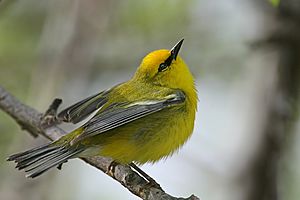
Order: Passeriformes Family: Parulidae
New World warblers are a group of small, often colourful, perching birds found only in the Americas. Most live in trees, but some live on the ground. Most members of this family eat insects.
| Common name | Scientific name | Irish name | Status |
|---|---|---|---|
| Blue-winged warbler | Vermivora cyanoptera | Ceolaire gormeiteach | A R |
See also
- List of birds
- Lists of birds by region


